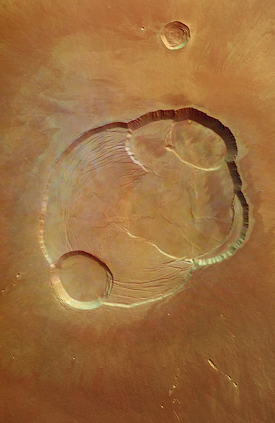Mars Express science highlights:
#5. Recent and episodic volcanism
Clearly, volcanic activity has been a major factor in the evolution of the martian surface, atmosphere and climate, but, until recently, it was thought that volcanism on Mars ceased around 500-600 million years ago. However, the High Resolution Stereo Camera (HRSC) on Mars Express returned pictures of the planet's surface, which clearly indicated that some of the massive volcanoes have been active much more recently than previously supposed.
 |
|
Detail of the complex caldera of Olympus Mons. Credit: ESA/DLR/FU Berlin (G. Neukum) |
The volcanoes with the most recent activity included Olympus Mons and three giant volcanoes in the Tharsis region: Arsia Mons, Pavonis Mons and Ascraeus Mons (collectively known as the Tharsis Montes). Their central calderas appeared to have been resurfaced within the last 20 million years, with the possibility of lava emanating from several small vents as recently as two million years ago. The data led some scientists to suggest that small-scale surface activity may be occurring today, such as hydrothermal systems involving heated ground water.
The dating of these volcanic edifices was derived from a technique that counted visible impact craters: generally speaking, a high density of impact craters per square kilometre indicates that the surface is older. A smooth area with a general absence of such craters favours a very young age.
The new ages derived from the HRSC data confirmed that the volcanoes in the Tharsis and Elysium regions have been sporadically active over billions of years - a remarkably long period of time compared with volcanoes on Earth. The images also revealed that activity in the summit calderas was periodic, consistent with theoretical predictions of cooling and depletion in magma reservoirs, followed by periods of magma regeneration and renewed eruptions.
The most recent summit caldera activity on the Tharsis volcanoes was clustered around 100-200 million years ago, but some of the youngest volcanism on the Tharsis Montes appeared to have taken place only a few million years ago, suggesting that these volcanoes are currently dormant and that they could erupt in the future.
The very long activity of martian volcanoes implies correspondingly long lifetimes for the 'hot spots' in the planet's interior - the sources of magma which feed the eruptions. Precisely how such plumes of magma could survive for such enormous periods of time is still unclear.
Another surprise was the discovery of a previously unknown explosive eruption on the north-western flank of the shield volcano Hecates Tholus. The eruption took place 350 million years ago, creating a 10 km diameter caldera. Since shield volcanoes usually emit runny lava that contains very little gas, such explosive activity had previously been thought to be confined to the planet’s early history.
